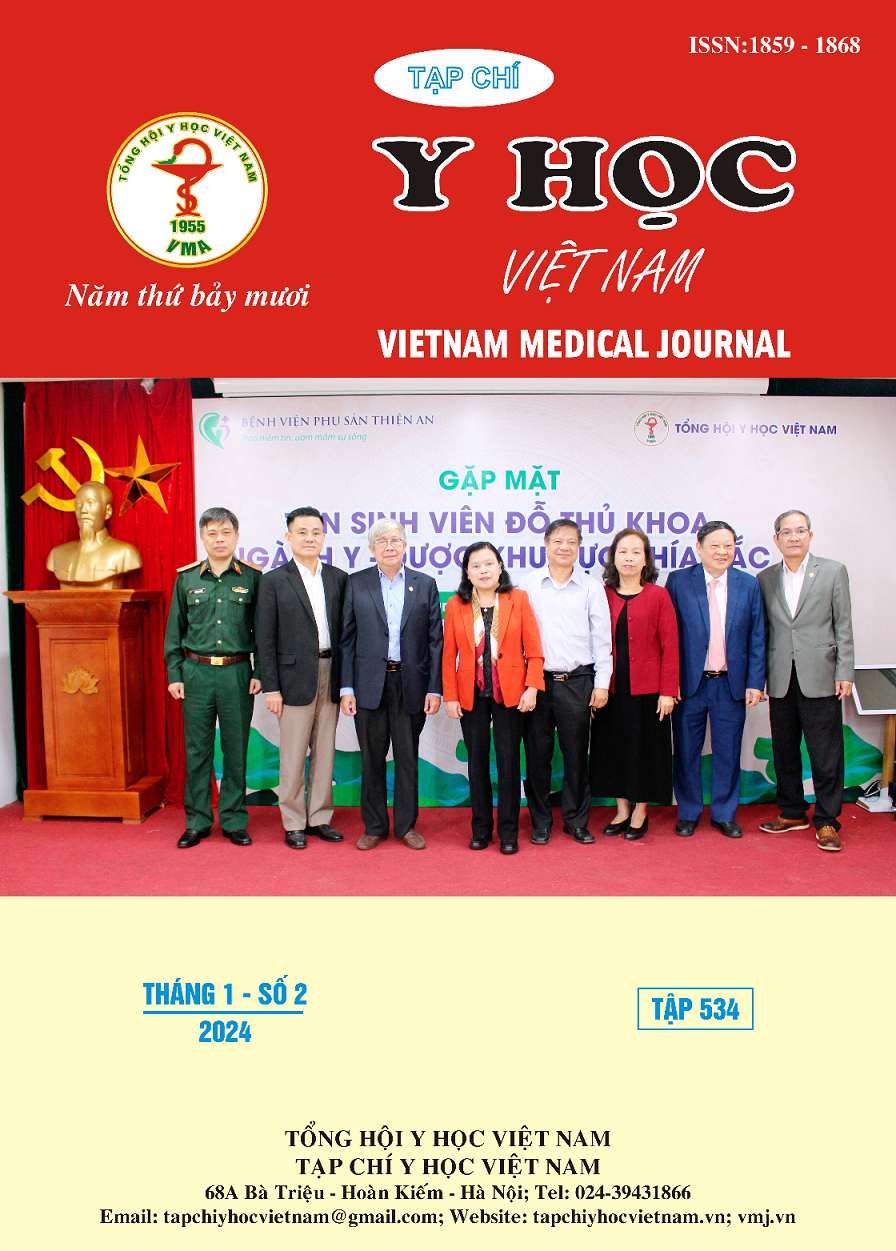THE OUTCOME OF INTERTROCHANTERIC FEMUR FRACTURE BY CLOSED CEPHALOMEDULLARY NAILS REDUCTION IN BACH MAI HOSPITAL
Main Article Content
Abstract
Objectives: Evaluating the initial outcome of closed cephalomedullary nail surgery in treatment of intertrochanteric femur fracture in Bach Mai hospital. Methods: We conducted a retrospective cross sectional descriptive study, evaluating the outcome of closed cephalomedullary nail surgery in 39 patients diagnosed with intertrochanteric femur fracture in the period of 2 years, from 1/2021 to 4/2023 at Bach Mai Orthopaedic and Spine Department. Results: The mean age was 67,6 ± 19,1 years. Average operative time 100,8 ± 10,4 minutes. The difference in operation time between 2 groups, short cephamedullary nail group (n1 = 17) and long cephamedullary nail group (n2 = 22) were 95 ± 4,7 and 105,2 ± 11,5 minutes, respectively (p = 0,01). Average blood loss was 181,4 ± 142,7 ml, discrimination of blood loss between 2 groups was statistically (98,8 ± 23,3 ml and 245,2 ± 163,3 ml) (p = 0,001). Average length of stay in hospital was 14,3 ± 6,7 days, the figure for short nails group was 9,0 ± 4,4 days, long nails group was 10,6 ± 6,1 days (p> 0,05). Intraoperative complications confirmed in 2 cases (5,1%), 1 case of femoral shaft fracture and 1 case of failure of closed reduction. Harris score at 03 and 06-month follow-up were 79,7 ± 13,5 and 85,5 ± 13,3 (p< 0,05), patients classified to good and very good postoperative functional group accounted for 70,8%. Conclusion: Closed cephalomedullary nails reduction is minimally invasive osteosynthesis technique in treatment of intertrochanteric femur fracture showed good outcome and short–term follow up.
Article Details
References
2. Dhaked GS. Dynamic Hip Screw versus Proximal Femoral Nail in the Management of Intertrochanteric Fractures - A Retrospective Analysis from Rajasthan. jebmh. 2021;26(8): 2349-2562. doi: 10.18410/ jebmh/2021/424
3. Jia X, Zhang K, Qiang M. The accuracy of intra-operative fluoroscopy in evaluating the reduction quality of intertrochanteric hip fractures. Int Orthop. 2020;44(6): 1201-1208. doi:10.1007/ s00264-020-04533-w
4. K Rahman MA, Siddiqui YS, Julfiqar M, Khan AQ, Sabir AB, Abbas M. Short versus long proximal femoral nail in the management of intertrochanteric fractures - a comparative study. Int J Burns Trauma. 2023;13(3):99-109.
5. Trương Quang Nhân. Đánh giá kết quả điều trị gãy liên mấu chuyển xương đùi bằng đinh PFNA. Luận văn chuyên khoa II y học, Đại học Y - dược, Đại học Huế. Published online 2021.
6. Dragosloveanu Șerban, Dragosloveanu C, Cotor D, Stoica C. Short vs. long intramedullary nail systems in trochanteric fractures: A randomized prospective single center study. Exp Ther Med. 2021;23(1): 106. doi:10.3892/ etm. 2021.11029
7. Herzog J, Wendlandt R, Hillbricht S, Burgkart R, Schulz AP. Optimising the tip-apex-distance in trochanteric femoral fracture fixation using the ADAPT-navigated technique, a longitudinal matched cohort study. Injury. 2019; 50(3): 744-751. doi:10.1016/ j.injury.2019. 02.010
8. Trần Trung Hiếu, Trần Trung Quyết. Đánh giá kết quả phẫu thuật kết hợp xương nẹp khóa điều trị gãy liên mấu chuyển xương đùi ở người cao tuổi. Tạp chí y học Việt Nam. 2021;503(1):235-239.
9. Sahin S, Ertürer E, Oztürk I. Radiographic and functional results of osteosynthesis using the proximal femoral nail antirotation (PFNA) in the treatment of unstable intertrochanteric femoral fractures. Acta Orthopaedica Et Traumatologica Turcica. 2010;44(2): 127-134. doi:10.3944/ AOTT.2010.2237
10. Zhao F, Guo L, Wang X, Zhang Y. Benefit of lag screw placement by a single- or two-screw nailing system in elderly patients with AO/OTA 31-A2 trochanteric fractures. J Int Med Res. 2021; 49(3): 030006052110037. doi:10.1177/ 03000605211003766


